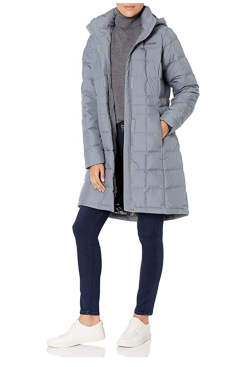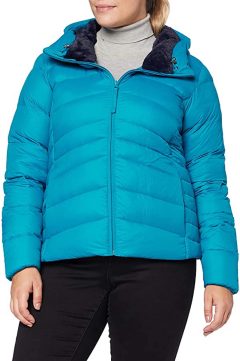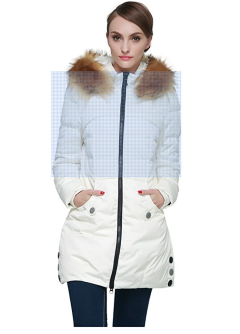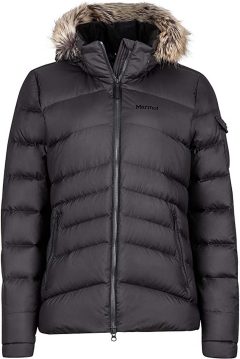BestReviews is reader-supported and may earn an affiliate commission. Details

A comprehensive design from a trusted brand.
Innovative omni-heat reflective material allows body heat to warm up interior of garment. It is 600 goose fill for severe weather conditions. Covers from upper body to the knees.
A few buyers wished it was warmer. Sizing tends to run big.

A short piece with 100% authentic insulation.
Features Columbia's omni-heat technology which is designed to retain heat while also being breathable. Also comes with an adjustable hood and zippered hand pockets.
Some users have noted that this runs small.

A good quality option that features a thickened fleece lining.
Windproof for excellent warmth and available to purchase in a variety of colors. It is surprisingly light despite its heavy-duty design. The fleece helps keep you impressively warm.
Smaller fit than most customers expected.

A highly-rated garment with a faux-fur hood.
The waist tightens for added warmth and the faux fur trim around hood is removable. Comes in four different colors and is extremely warm considering the cheaper price tag.
Some buyers wish it was thicker.

A 700-fill choice ideal for the coldest months.
Made out of a durable water-resistant polyester fabric that keeps you dry. It features a 700 fill power to keep you warm even in the coldest winter months. The hood features a stylish faux fur trim.
Some users hoped for a warmer garment.

We recommend these products based on an intensive research process that's designed to cut through the noise and find the top products in this space. Guided by experts, we spend hours looking into the factors that matter, to bring you these selections.

Ready for plunging temperatures? Having the right outerwear is the key to enjoying cold weather to the fullest, so choosing a women’s down jacket is an important decision.
As bulky as they look, down jackets are incredibly lightweight since they’re filled with duck or goose feathers. This unique fill provides unmatched warmth in chilly temperatures, and in some styles, only minimal layering beneath it is necessary.
The signature puffy look of down jackets is now a style staple in winter fashion — it’s created by geometric quilted patterns that render each jacket different from the next. All things considered, women’s down jackets are the crown jewel of functional fashion in freezing temperatures.

Synthetic fill jackets are generally less expensive options, so you can actually get more than one for the same price as a single down jacket. They’re also warm alternatives if you’re allergic to feathers. Even so, synthetic fill jackets are not as warm as down, so you most likely need a few layers beneath them. They also don’t have the same longevity as down jackets.
Down fill jackets are extremely warm and have a luxurious, fluffy, and lightweight feel to them. Depending on the style, you may not need to wear several layers beneath them, except in extreme temperatures. Down fill jackets are usually more expensive than synthetic alternatives, so they’re more of an investment. They’re obviously not for those who are sensitive or allergic to feathers.
You may notice down jackets are marked with numbers like “600g” or “500g” down. This refers to how much the fill weighs. The higher the number, the more it weighs — and the warmer the jacket. Moderate quality weight is up to 600g, and high-quality weight ranges from 650g to 750g. If you’re looking for the highest quality, aim to get 800g or higher fill weight in your down jacket.
Women’s down jackets come in four main lengths: waist and hip, mid-thigh, calf, and full-length. Waist and hip styles are the sportiest jackets, but if you have a longer torso, they may be too short and leave your waist and lower back susceptible to drafts. Mid-thigh lengths make sure most of your bottom is covered, even if you’re moving and bending. They’re well-suited for active individuals but may not be enough for those who spend a lot of time in colder temperatures.
Calf lengths fall anywhere between the knee and the ankle. These are a good choice if you need warmth that covers the majority of the body, especially the areas that boots don’t reach. For maximum coverage, which is especially important in extreme temperatures, full-length styles are best. They fall closer to the ankle and often feature A-line silhouettes to allow for ample range of motion while walking.

Despite the fact that down jackets are intended for cold, wet weather, not all of them come with hoods. Coats with hoods are either sewn on or removable, with the latter being more common. Removable hoods are snapped, zippered, or buttoned off and on, making them ultra-convenient to transition between styles. Depending on how it’s attached, the procedure can take a few minutes.
Down jackets vary quite a bit at the cuffs. Some are essentially open and just as wide as the rest of the sleeve. Others taper at the wrist to eliminate drafts. This area is a point of contention for consumers, as cuffs are often too tight or too wide, and sleeves can be the wrong length. To find a down jacket with more precise sizing to suit your arm length, consider styles that have a broad size range, including petite and tall.
Some down jackets have adjustable features courtesy of Velcro, bungee cords, or drawstrings. When located at the jacket’s middle section, their intentions are to create more of an illusion of a waist in an otherwise boxy style. Cuffs are often adjustable as well so they can be customized to seal off any drafts, especially over gloves.
Select down jackets feature special lining, mostly in the form of fleece and faux shearling. Generally speaking, this lining only covers the torso or certain panels around the face. Since these materials are highly absorbent, limiting their presence to the top part of the jacket means they won’t be exposed to moisture and saturate the jacket from the bottom up.
Down jackets are often equipped with various degrees of weather resistance, which mostly depends on their shell materials — normally polyester and nylon. Quality down jackets are, at the very least, water-resistant. There are some hardshell styles that are windproof as well, which means the weave of the material won’t allow wind to penetrate the jacket.

Women’s down jackets cost between $60 and $400. The price depends not only on the quality of the fill, but also on how well designed the jacket is to protect you in colder temperatures.
You can pick up a wallet-friendly down jacket for less than $100. For the most part, you can only find waist or hip-length styles, and only some come with hoods.
If you’re looking for a longer jacket with better cold-weather features, expect to spend between $100 and $200. These styles often include removable hoods, more pockets, and wrist cuffs.
For premium down jackets from major labels, you can spend between $200 and $400. These jackets are typically long and full-length styles. In addition to a variety of adjustability options, they sometimes have fur trim.


A. Before choosing a cleaning method, reach out to the jacket manufacturer for their recommended instructions. Some manufacturers recommend having down jackets cleaned professionally to be safe. Others say you can wash it at home, provided you have a front-loading washing machine since top-loading models have agitators that are too rough for down jackets. In terms of drying, some jackets are best left to air dry, while others are fine on tumble dry low with some tennis balls to help the feathers stay fluffy.
A. Keep your jacket in a closet with ample space around it to breathe and move freely. The last thing you want to do is stuff it in a tightly packed rack of clothing, as it can compress and de-fluff the feathers. You may need to rearrange your closet or wardrobe to make sure your down jacket is properly stored.
A. When traveling to a colder destination, it’s a good idea to keep your outerwear with your other carry-on items in an overhead compartment. With that said, you’ll probably be short on space when you travel, so consider getting a lightweight down jacket instead. These thin yet warm packable jackets can fit into small bags and are comfortable to wear all day. You might need to have a couple of base layers, but at least you won’t have to carry around “puffer bulk” on your trip.
Get emails you’ll love.
Learn about the products you’re wondering if you should buy and get advice on using your latest purchases.
